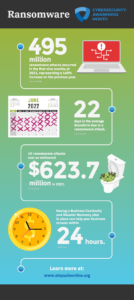Cybersecurity has become one of the biggest hot topics both inside and outside of technology circles over the last few years. Everyone not only in Small Business, but governments, large corporations and all of us as individuals are impacted. Increasing challenges ranging from securing many different device types and the rise in remote work during the COVID-19 pandemic to coping with the fallout of high-profile breaches of national infrastructure such as the Colonial Pipeline, there is a seemingly endless news cycle dedicated to cybersecurity issues.
With all the negative news, it can be easy for everyday individuals to become overwhelmed and to feel powerless in the face of the threats posed by cybersecurity, or lack thereof. Some feel it is beyond everyday people to fight and that it should be left to the professionals. But this just isn’t true. In fact, all of us have a huge role to play in cybersecurity threat prevention, detection, and remediation. For example, according to IBM, 95% of breaches have human error as a main cause. Therefore, everyday technology users are very much the first line of defense when it comes to thwarting cybercrime. Unfortunately, many individuals are not aware of some of the best practices for boosting cybersecurity and how easy they are to use. With that, here are four best practices that you can implement today to enhance your own cybersecurity and create a more secure world for everyone:
1) Watch out for Phishing
Phishing – when a cybercriminal poses as a legitimate party in hopes of getting individuals to engage with malicious content or links – it remains one of the most popular tactics among cybercriminals. In fact, 80% of cybersecurity incidents stem from a phishing attempt. However, while phishing has gotten more sophisticated, keeping an eye out for typos, poor graphics and other suspicious characteristics can be a tell tale sign that the content is potentially coming from a “phish.”
If you think you have spotted a phishing attempt be sure to report the incident so that internal IT teams and service providers can remediate the situation and prevent others from possibly becoming victims. This is the most basic area to train your team on. Do not click on suspicious links in emails. If an email refers to what appears to be a legitimate website, it is safest to go there directly vs clicking on the link in it.
2) Update Your Passwords and Use a Password Manager
Don’t write down or use weak passwords. No legitimate tech support or financial institution will ever ask for your password. Having unique, long and complex passwords is one of the best ways to immediately boost your cybersecurity. Yet, only 43% of the public say that they “always” or “very often” use strong passwords. Password cracking is one of the go-to tactics that cybercriminals turn to in order to access sensitive information. And if you are a “password repeater,” once a cybercriminal has hacked one of your accounts, they can easily do the same across all of your accounts.
One of the biggest reasons that individuals repeat passwords is that it can be tough to remember all of the passwords you have. Fortunately, by using a password manager, individuals can securely store all of their unique passwords in one place. Meaning, people only have to remember one password. In addition, password managers are incredibly easy to use and can automatically plug-in stored passwords when you visit a site.
3) Enable MFA
Yes, this can feel like a painful extra step but is worth it. Enabling multi-factor authentication (MFA) – which prompts a user to input a second set of verifying information such as a secure code sent to a mobile device or to sign-in via an authenticator app – is a hugely effective measure that anyone can use to drastically reduce the chances of a cybersecurity breach. In fact, according to Microsoft, MFA is 99.9 percent effective in preventing breaches. Therefore, it is a must for any individual that is looking to secure their devices and accounts.
4) Activate Automatic Updates
Making sure devices are always up-to-date with the most recent versions is essential to preventing cybersecurity issues from cropping up. Cybersecurity is an ongoing effort, and updates are hugely important in helping to address vulnerabilities that have been uncovered as well as in providing ongoing maintenance. Therefore, instead of trying to remember to check for updates or closing out of update notifications, enable automatic update installations whenever possible.
Think through
Now in its 19th year, Cybersecurity Awareness Month continues to build momentum and impact with the ultimate goal of providing everyone with the information they need to stay safer and more secure online. I am proud to support this far-reaching online safety awareness and education initiative which is co-led by the National Cyber Security Alliance and the Cybersecurity and Infrastructure Agency (CISA) of the U.S. Department of Homeland Security.
For more information about Cybersecurity Awareness Month 2022 and how to participate in a wide variety of activities, visit staysafeonline.org/cybersecurity-awareness-month/. You can also follow and use the official hashtag #BeCyberSmart on social media throughout the month.
Have you experienced a cybersecurity attack? If so, how did you deal with it? Any recommendations on best practices you have implemented since that time?
Feel free to post comments or email them to me. Small Business, Big Lessons ® – How are you staying Cybersecurity aware?
Small Business
About the Author:
 Gregory Woloszczuk is an entrepreneur and experienced tech executive that helps small business owners grow their top and bottom line. Gregory believes in straight talk and helping others see things they need to see but may not want to with a focus on taking responsibly for one’s own business. He and his wife, Maureen, started GMW Carolina in 2006.
Gregory Woloszczuk is an entrepreneur and experienced tech executive that helps small business owners grow their top and bottom line. Gregory believes in straight talk and helping others see things they need to see but may not want to with a focus on taking responsibly for one’s own business. He and his wife, Maureen, started GMW Carolina in 2006.
Chapelboro.com does not charge subscription fees, and you can directly support our efforts in local journalism here. Want more of what you see on Chapelboro? Let us bring free local news and community information to you by signing up for our biweekly newsletter.


